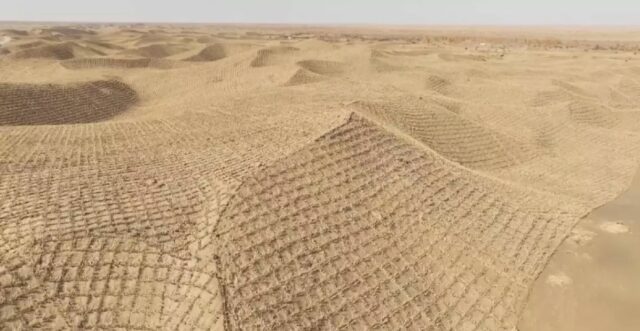China has finished a 46-year campaign to encircle Taklamakan, its largest desert with trees as part of national efforts to end desertification.
Chinese State media reported on Friday that the effort is aimed at curbing the sandstorms that plague parts of the country during the spring
A “green belt” of about 3,000 km (2,000 miles) around the Taklamakan was completed on Thursday in the northwestern region of Xinjiang.
The work was completed after workers planted the final 100 metres of trees on the desert’s southern edge, the Communist Party-run People’s Daily said.
The Taklamakan desert is also called the sea of death to highlight its harsh and inhospitable terrain.
The desert’s name is derived from the Uyghur language and means “the place of no return”, or “sea of death“.
Efforts to enclose the desert with trees began in 1978 with the launch of China’s “Three-North Shelter belt” project, colloquially known as the Great Green Wall.
More than 30 million hectares (116,000 square miles) of trees have been planted.
Tree planting in the arid northwest has helped bring China’s total forest coverage above 25% by the end of last year, up from around 10% in 1949.
Forest coverage in Xinjiang alone has risen from one per cent to five per cent in the last 40 years, the People’s Daily said.
The shelter belt project has involved decades of experimentation with different tree and plant species to determine which is the hardiest.
Critics say that survival rates have often been low, and it has been ineffective in reducing sandstorms, which routinely reach the capital Beijing.
China will continue planting vegetation and trees along the edge of the Taklamakan to ensure that desertification is kept in check, Zhu Lidong, a Xinjiang forestry official, told media persons in Beijing.
He said poplar forests on the northern edge of the desert would be restored through the diversion of flood waters.
Apart from this, officials were also planning new forest networks to protect farmland and orchards on the western edge.
Despite China’s tree planting efforts, 26.8% of its total land is still classified as “desertified”, according to official data from the forestry bureau.
(With inputs from Reuters)
Delhi based journalist pickled in journalism. Have reported from nine world capitals and almost all parts of India. Over the last three decades, I have worked for India’s mainstream English dailies and contributed to All India Radio, Doordarshan and Women’s Feature Service. Also worked for international media including Japan’s leading newspaper, The Asahi Shimbun and done assignments for The Sunday Times, London, The Telegraph, The Guardian and the Canadian Broadcasting Corporation. Worked in the Embassy of France in New Delhi and can speak French to save my life. Write on Diplomacy, Politics and the social sector. Love Nature, heritage, Nature, animals and vintage cars. Enjoy cycling and playing badminton.





